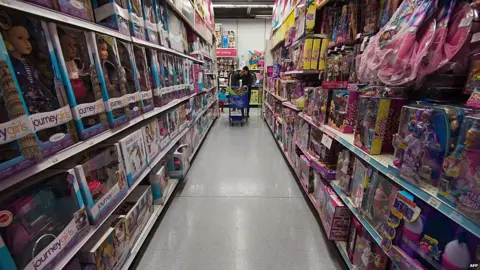Children's toys: The backlash against pink and blue branding
 AFP
AFPAs more and more parents push back against gender stereotypes, retailers are choosing to throw out the pink and blue rule book and embrace a gender-neutral approach to marketing children's toys and clothing.
Growing up in the 1970s, mum Tessa Trabue never thought too hard about the significance of just two colours, pink and blue.
But when her son was born in 2006, she started to notice the way society likes to colour-code the sexes.
At a magazine stand one day, her son pointed out a children's magazine he wanted to buy.
"But his hand snapped back and he said 'look mummy I can't have it, that sign says just for girls'," Trabue told the BBC.
"I was just flabbergasted."
The incident was one of several that opened her eyes to the way children's clothing and toy manufacturers aggressively market by gender.
Now a member of the Let Toys Be Toys campaign in the UK launched in 2012, Trabue tries to put pressure on children's brands to expand their marketing to include both genders so that no little boy or girl thinks they are playing with "the wrong toy".
The organisation says 15 retailers across the UK, including Boots and John Lewis, have removed "boys" and "girls" signs from their marketing.
"We're not against pink, we're not against blue," Trabue says. "Children can play with all toys, it's just signs or people that tell them they can't."
Children's toys weren't always this gendered, says professor Elizabeth Sweet, who researches gender and toys at San Jose State University in California.
"Toys were much less gendered historically than they are today," she told the BBC.
Some of the hottest toys of the mid-century - tiddlywinks, slinkies and silly putty - were enjoyed by all. In her surveys of vintage catalogues, Sweet notes that both genders would often play with a toy, or play with a toy that might challenge their gender stereotype.
Toys that were gendered tended to focus on occupations the child might have in the future - baby dolls for girls, or building blocks for boys.
But by the 1990s, things started to shift, Sweet says, in part as a reaction to the women's revolution in the 70s and the growth of women in the workplace in the 1980s.
Popular books like "Men are from Mars, Women are from Venus" and the "The Female Brain" emphasised the inherent differences between men and women.
And that way of thinking about gender spilled over into children's toys, she says.
Toy manufacturers will now often create two sets of the same toy, in different colours, marketed to different genders.
Gendered children's toys have also changed from being occupation-focused to fantasy-focused, she says.
"Away go the little homemaker and what I call the young man of industry, and in their place come the princess and the superhero," she says.
"Those stereotypes were woven into a fantasy world and somehow became more palatable to people."
There are signs of backlash against these rigid norms.
In addition to the strides made in the UK, retailers around the world are beginning to feature more gender-neutral marketing and gender-neutral products. In this year's Christmas catalogue, Canadian retailer Canadian Tire included gender-neutral images of children playing.
 Canadian Tire
Canadian TireOn one page, a girl was seen playing with a power tool, while another page featured a boy enjoying a play kitchen set.
"The imagery in the WOW Guide was intentionally chosen because we encourage all kids to play, create and dream with whatever toy is on their wish list," says Carolyn McPherson, associate vice president of Kids Fun at Canadian Tire.
"We believe it is so important to provide the fun stuff that allows kids to imagine and grow, unhindered by traditional gender stereotypes."
The trend has gone beyond toys and even extended to clothes. Abercrombie and Fitch and John Lewis each launched a unisex children's line in 2017.
And in one of the most memorable online ads of the year, upmarket children's clothing brand Nununu partnered with singer Celine Dion to launch a clothing line with "gender neutrality for little people with freedom of mind".
Although Nununu has featured unisex items in the past, this collaboration is unique in that there are no "boys" or "girls" sections for the clothing on the website.
Allow X content?
The ad features Dion in full camp mode, breaking into a hospital and evading authorities while she blows equality fairy dust on newborn babies bundled in pink and blue blankets.
There has been growing demand for unisex clothing, says Shelly Ziv, the chief business officer for Israeli company Nununu.
Responses to the campaign have been both positive and negative, she says.
"We've had these amazing responses ... people who are loving the message and loving the brand. And naturally also people who are not fans, and who it's not their cup of tea," Ziv told the BBC.
"Anything that is different from what people define as the norm... is maybe even scary sometimes."
